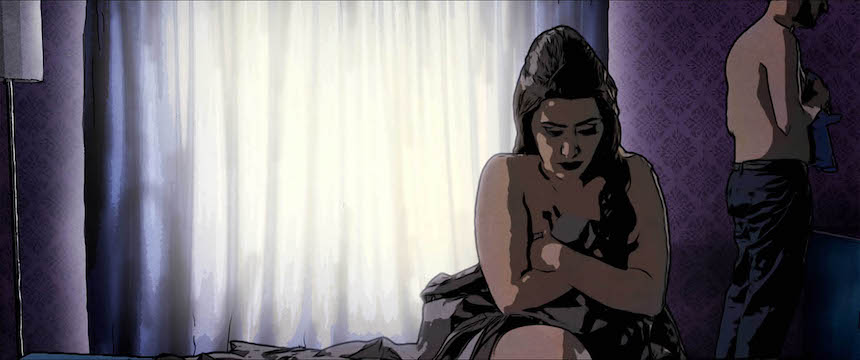Sitges 2017 Review: TEHRAN TABOO, a Savage Look at the Paradox that is Modern Iran
Ali Soozandeh’s brisk animated feature displays an often absurdist energy and comic wit.

Blunt, angry and eye-opening, Tehran Taboo offers a scathing portrait of Iran’s largest city. Think of it as Short Cuts meets Persepolis, although that facile shorthand does not begin to get at just how much is going on, plot and character wise, in Ali Soozandeh’s brisk animated feature.
This is instantly clear from the first scene where a woman is trying to administer a blow job to a cabbie who cannot get it up, and crashes his car in a fit of rage upon spotting his daughter holding hands in public. The woman's young son is in the back of the cab, bored, while all of this is going on with the implaction that this grotesque farce has happend often enough to become part of the landscape.
The soundtrack is a hodgepodge of news clips of the day, burger advertisements (one of many recurring motifs), and the noisy nightlife sounds of any large urban metropolis approaching 10 million souls. The density of sensation for our entry into a world, one that many will have little to no familiarity with, is staggering. And Soozandeh is just getting started.
Pari is turning tricks for impotent cabbies because her husband is in jail and unable to either sign divorce papers, or provide written consent for her to get any more legitimate form of employment to support herself and her son. The magistrate doesn’t not take pity on her situation, but rather he exploits the circumstances with the leading promise of forgoing the signatures if she becomes his exclusive woman on the side of his marriage.
He sets her up in an apartment, where she meets Sara, a pregnant and reluctant housewife who is stymied by her husband in going back to work after the baby is born and has to look after her ailing diabetic father-in-law who keeps slipping himself bonbons while watching pornography and turning the channel to politics or prayer, hiding the candy as it were, when anyone else wanders in the room.
Sara's husband works at a bank, and he turns down the request for a large loan for a student musician, Babak, who is being threatened by a woman with whom he had a drug fuelled one-night stand in nightclub. The woman, Donya, is getting married soon, and absent her hymen, there is going to be trouble with her hulking, possibly military or gangster, boyfriend, so she wants Babak to fund a surgery to restore her virginity before the wedding. Babak’s brother Moshen is a fountain of illegal schemes and dead-end solutions, and coincidental encounters with Pari and Sara on the city streets weave a tangled web indeed.
The point of all this convoluted plotting provides ample opportunities to show the hypocrisy that results from the morally rigid social structure and control imposed by fear and bureaucracy in Iranian civil life. People are going to be people, they have vices and make poor, often overly emotional choices.
Many of these small choices, often made out of a yearning for convenience or pleasure, cause an ever widening ripple effect that can swallow a persons entire existence. Events spiral into a frenzy that evokes Asghar Farhadi's Oscar winner, A Seperation, but faster and more furious to reflect the youth of his characters, and the animated medium.
But the animation also provides opportunites to linger on specific details like Paris condoms used as water balloons to occupy her son, or an inconvenient litter of kittens in the tight spaces of thier concrete high-rise. A single viewing is probably not enough to take it all in, particularly with the plot-heavy narrative.
Tehran Taboo was produced in Germany, presumably to avoid the exact type of censorship that many of the characters in the film encounter. Shooting the actors against green screens, then animating them into a stylized modern-day Tehran, the swirl of the city, with its busy streets and cramped interior spaces, is amply integrated by rotoscoping the actors into the animated sets. This will be familiar to those who have seen some of Ralph Bakshi’s work or Richard Linklater’s Waking Life.
Soozandeh structures several orienting transitions using a passport photobooth, a great irony as none the characters seem to be able to leave the country. However each of them make a visit with the requirement of different photos for different bureaucratic purposes, and the colour of the background screen the photographer uses offers provides foreshadowing and context.
Each of the principal characters has at least three character arcs going on simultaneously, one where they are the victim, one where they are the antagonist, and one where they are empathetically human. Multiply this across the number of characters and one would think this would be a hard movie to follow, but quite the opposite, Soozandeh keeps all the plates spinning with a stunning virtuosity. The intended effect is not to simply create villains and heroes, everyone in is flawed, but the system is the true antagonist.
Tehran Taboo throws ample light on the litany of double standards and curious paradoxes of Urbane Iranian culture with an often absurdist energy and comic wit. It is a vibrant and worthy trip that manages to squeeze a bit of poetry into the bombast, burger ads and all.

Do you feel this content is inappropriate or infringes upon your rights? Click here to report it, or see our DMCA policy.






